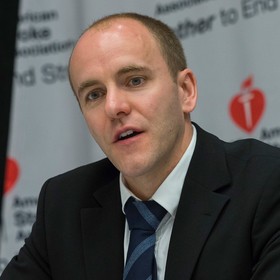06 Mar Vagus Nerve Stimulation Safe and Feasible For Stroke Rehabilitation
MedicalResearch.com Interview with:
Jesse Dawson MD, BSc (Hons), FRCP, FESO
Clinical Reader / Honorary Consultant
Clinical Lead Scottish Stroke Research Network / NRS Stroke Research Champion
Chair MVLS Research Ethics Committee
Institute of Cardiovascular and Medical Sciences
College of Medical, Veterinary & Life Sciences
University of Glasgow
MedicalResearch.com: What is the background for this study? What are the main findings?
Response: Many patients suffer long term arm weakness after stroke and there are few effective treatments. We are assessing whether stimulation of the vagus nerve can improve recovery after stroke. Stimulation of the vagus nerve, called VNS for short, triggers the release of neurotransmitters in the brain. These neurotransmitters are important for learning and memory. Pre-clinical studies have shown that combining vagus nerve stimulation with movement or rehabilitation tasks enhances brain plasticity, improves motor learning and leads to better recovery after stroke.
Based on this, we performed a clinical trial in patients with arm weakness after stroke and found promising changes in the patients treated with VNS paired with rehabilitation compared to rehabilitation alone.
In this study we performed a double blind sham stimulation controlled study of VNS paired with rehabilitation vs sham stimulation in patients with long term arm weakness due to ischaemic stroke. All participants were implanted with a VNS device and underwent a course of therapy. We didn’t see a statistically significant difference after 6 weeks of intensive in-clinic therapy but saw a large and significant difference after a further 60 days home exercise treatment with VNS. There were differences on several measures, including the clinical response rate which was 88% with VNS and 33% with controls.
MedicalResearch.com: Tell us about this device please.
Response: The device is similar to other nerve stimulators, and in fact the surgery to implant a similar device has been performed more than 100,000 times for people with epilepsy. For our therapy the stimulator is placed in the chest just below the collar-bone and a lead wire runs under the skin and is wrapped around a nerve in the neck – called the vagus nerve – which is stimulated during rehabilitation movements.
MedicalResearch.com: What should readers take away from your report?
Response: Rehabilitation alone may not be sufficient to enhance motor recovery after stroke. Pairing vagus nerve stimulation with rehabilitation may motor function after stroke and I looks like this recovery improves over time. This offers a potential treatment for patients with chronic arm weakness after stroke. The gains we saw did impact patients lives and are likely to be clinically meaningful. This is promising but larger definitive studies are needed.
MedicalResearch.com: What recommendations do you have for future research as a result of this study?
Response: A phase III pivotal trial is planned in the US and UK, pending FDA and other approvals. We may extend our research to include patients with hemorrhagic stroke, not just ischaemic stroke.
MedicalResearch.com: Is there anything else you would like to add?
Response: The study was supported by MicroTransponder, Inc., a medical device company based in Dallas. MicroTransponder is currently testing the VNS device in patients with chronic tinnitus and stroke.
MedicalResearch.com: Thank you for your contribution to the MedicalResearch.com community
Citation:
A Randomized Double-Blind Pilot Study Assessing Vagus Nerve Stimulation (VNS) During Rehabilitation for Improved Upper Limb Motor Function After Stroke
Jesse Dawson | University of Glasgow, Glasgow, United Kingdom
RESULTS: Vagus Nerve Stimulation is safe and feasible for stroke rehabilitation; arm function improved.
Note: Content is Not intended as medical advice. Please consult your health care provider regarding your specific medical condition and questions.
More Medical Research Interviews on MedicalResearch.com
[wysija_form id=”5″]
Last Updated on March 6, 2017 by Marie Benz MD FAAD

